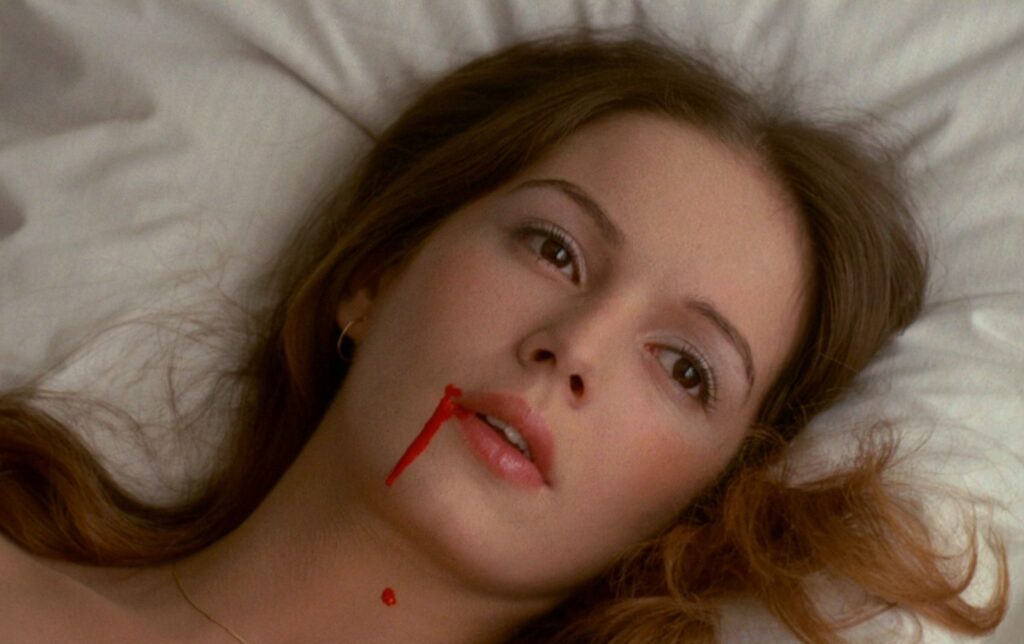
Glissements progressifs du plaisir (1974) opens with a police lieutenant (Jean-Louis Trintignant) arriving at a crime scene to interview a young woman (Anicée Alvina) suspected of murder. When the policeman enters the apartment he finds the young woman sitting on a bed beside her roommate (Olga Georges-Picot) who has been stabbed with a pair of scissors. After being arrested, the young woman is interviewed at length by a judge (Michael Lonsdale) and then later by her lawyer (Olga Georges-Picot again).
Filmmaker Alain Robbe-Grillet continues his application of Nouveau roman strategies and techniques with Glissements progressifs du plaisir. As with many of his films in the seventies Robbe-Grillet extends the Nouveau roman strategies beyond the non-linear format of his storytelling and into both the montage and production design of the film. In Glissements progressifs du plaisir Robbe-Grillet is specifically interested in the visual signifiers that have been codified within the exploitation genres of the European crime film, the horror film, nunsploitation, and school girl sexploitation.
The very nature of the narrative of Glissements progressifs du plaisir motivates these inquiries in a quasi-reflexive fashion. But it is in the structure of the plot, the avant-garde approach to montage and in the production design that Robbe-Grillet distills the cinematographic language of these genres to their most primal visual cues. These cues range from insert shot of a nude nun kneeling before a whip to a close-up of black leather gloves against a white backdrop. These isolated images are stacked with meaning to the viewer which the investigation within the film gradually analyzes without every explaining or trivializing their complexity.
Glissements progressifs du plaisir, like any film by Robbe-Grillet, is as much about navigating a specific visual complex as it is about erotic spectacle. The erotic impulse of Glissements progressifs du plaisir doesn’t hinder Robbe-Grillet’s fourth-wall breaking probes into aesthetic mechanisms, it actually aids it. The reductiveness inherent to erotic serves to keep the characters in Glissements progressifs du plaisir plastic archetypes without ever jeopardizing their individual agency. Robbe-Grillet’s post-modernist intellect relies on this synthesis of cinematic reflexivity and fetishism to execute his investigation into what Christian Metz termed “the cinematographic langue”.
However, Robbe-Grillet is not content to merely scrutinize the intertextuality of film language across genres. Glissements progressifs du plaisir is also a Kafka-esque satire of the patriarchal institutions of the criminal justice system and of the Catholic Church. Both institutions are depicted as comically inept and hypocritical just as they both tend to fear the unchecked sexuality of women. Anicée Alvina’s character in Glissements progressifs du plaisir is imprisoned as much for her liberated behavior as for the suspicion of murder.
What’s interesting about Robbe-Grillet’s political agenda is that it works in tandem with the aesthetic mechanisms at work in Glissements progressifs du plaisir. The visual iconography of Catholicism clearly intersects with those images associated with the giallo genre such as in the Theotokos. Likewise the restraints used in the criminal justice system correspond to the bondage images of horror, nunsploitation, sexploitation and, more obviously, the crime film. In his way Robbe-Grillet equates these genres that trade on sexualized sensationalism with revered societal institutions.
The key to this complex of genre, politics, and form is blood or the illusion of it. Not only is blood sacred to church and state alike, but its representation is essential to the working of icons and signifiers across all genres and cultures. Blood in Glissements progressifs du plaisir means murder, creation (red paint on paper), sex (red paint on a priest’s lips), love (the kiss on the rocky beach), etc. There’s a macabre atmosphere that permeates the stylish modernism of Robbe-Grillet’s visuals that prompts comparisons to Jess Franco and Jean Rollin. Almost in spite of himself Robbe-Grillet cannot seem to resist the urge to subtly embrace those genres he’s cobbled together in Glissements progressifs du plaisir.
